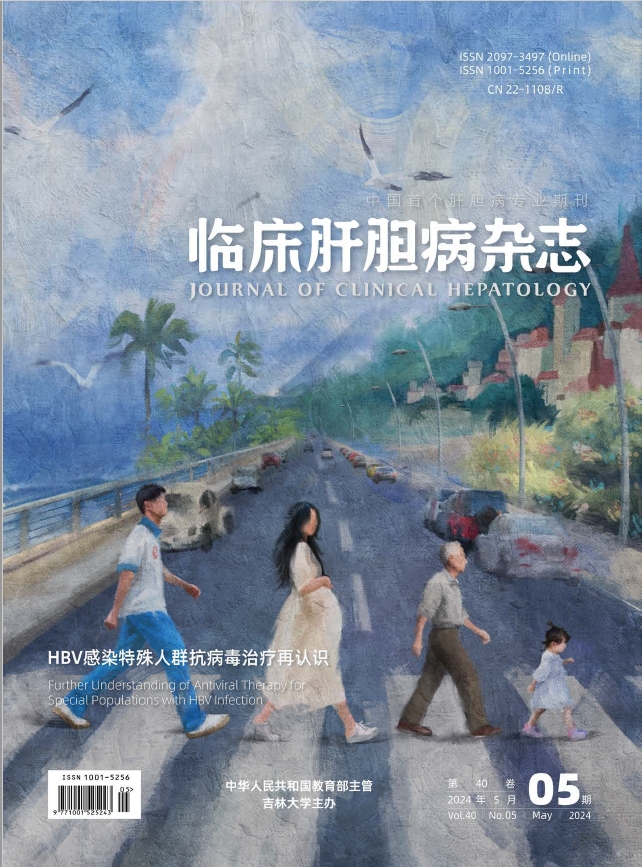| [1] |
KARLAS T, PETROFF D, SASSO M, et al. Individual patient data meta-analysis of controlled attenuation parameter(CAP) technology for assessing steatosis[J]. J Hepatol, 2017, 66( 5): 1022- 1030. DOI: 10.1016/j.jhep.2016.12.022. |
| [2] |
SINGH S, ALLEN AM, WANG Z, et al. Fibrosis progression in nonalcoholic fatty liver vs nonalcoholic steatohepatitis: A systematic review and meta-analysis of paired-biopsy studies[J]. Clin Gastroenterol Hepatol, 2015, 13( 4): 643- 654. e1-9; quize39-40. DOI: 10.1016/j.cgh.2014.04.014. |
| [3] |
LI J, YANG HI, YEH ML, et al. Association between fatty liver and cirrhosis, hepatocellular carcinoma, and hepatitis B surface antigen seroclearance in chronic hepatitis B[J]. J Infect Dis, 2021, 224( 2): 294- 302. DOI: 10.1093/infdis/jiaa739. |
| [4] |
REEDER SB, CRUITE I, HAMILTON G, et al. Quantitative assessment of liver fat with magnetic resonance imaging and spectroscopy[J]. J Magn Reson Imaging, 2011, 34( 4): 729- 749. DOI: 10.1002/jmri.22775. |
| [5] |
LE TA, CHEN J, CHANG C, et al. Effect of colesevelam on liver fat quantified by magnetic resonance in nonalcoholic steatohepatitis: a randomized controlled trial[J]. Hepatology, 2012, 56( 3): 922- 932. DOI: 10.1002/hep.25731. |
| [6] |
LOOMBA R, SIRLIN CB, ANG B, et al. Ezetimibe for the treatment of nonalcoholic steatohepatitis: Assessment by novel magnetic resonance imaging and magnetic resonance elastography in a randomized trial(MOZART trial)[J]. Hepatology, 2015, 61( 4): 1239- 1250. DOI: 10.1002/hep.27647. |
| [7] |
Chinese Medical Association, Chinese Society of Infectious Disease. Guidelines for the prevention and treatment of chronic hepatitis B(2022 version)[J]. Chin J Infect Dis, 2023, 41( 1): 3- 28. DOI: 10.3760/cma.j.cn311365-20230220-00050. |
| [8] |
CAUSSY C, ALQUIRAISH MH, NGUYEN P, et al. Optimal threshold of controlled attenuation parameter with MRI-PDFF as the gold standard for the detection of hepatic steatosis[J]. Hepatology, 2018, 67( 4): 1348- 1359. DOI: 10.1002/hep.29639. |
| [9] |
MISE Y, SATOU S, SHINDOH J, et al. Three-dimensional volumetry in 107 normal livers reveals clinically relevant inter-segment variation in size[J]. HPB, 2014, 16( 5): 439- 447. DOI: 10.1111/hpb.12157. |
| [10] |
TOKUSHIGE K, IKEJIMA K, ONO M, et al. Evidence-based clinical practice guidelines for nonalcoholic fatty liver disease/nonalcoholic steatohepatitis 2020[J]. J Gastroenterol, 2021, 56( 11): 951- 963. DOI: 10.1007/s00535-021-01796-x. |
| [11] |
TOKUSHIGE K, IKEJIMA K, ONO M, et al. Evidence-based clinical practice guidelines for nonalcoholic fatty liver disease/nonalcoholic steatohepatitis 2020[J]. J Gastroenterol, 2021, 56( 11): 951- 963. DOI: 10.1007/s00535-021-01796-x. |
| [12] |
PARK CC, NGUYEN P, HERNANDEZ C, et al. Magnetic resonance elastography vs transient elastography in detection of fibrosis and noninvasive measurement of steatosis in patients with biopsy-proven nonalcoholic fatty liver disease[J]. Gastroenterology, 2017, 152( 3): 598- 607. e 2. DOI: 10.1053/j.gastro.2016.10.026. |
| [13] |
HERNANDO D, SHARMA SD, ALIYARI GHASABEH M, et al. Multisite, multivendor validation of the accuracy and reproducibility of proton-density fat-fraction quantification at 1.5T and 3T using a fat-water phantom[J]. Magn Reson Med, 2017, 77( 4): 1516- 1524. DOI: 10.1002/mrm.26228. |
| [14] |
VU KN, GILBERT G, CHALUT M, et al. MRI-determined liver proton density fat fraction, with MRS validation: Comparison of regions of interest sampling methods in patients with type 2 diabetes[J]. J Magn Reson Imaging, 2016, 43( 5): 1090- 1099. DOI: 10.1002/jmri.25083. |
| [15] |
BONEKAMP S, TANG A, MASHHOOD A, et al. Spatial distribution of MRI-Determined hepatic proton density fat fraction in adults with nonalcoholic fatty liver disease[J]. J Magn Reson Imaging, 2014, 39( 6): 1525- 1532. DOI: 10.1002/jmri.24321. |
| [16] |
KANG BK, KIM M, SONG SY, et al. Feasibility of modified Dixon MRI techniques for hepatic fat quantification in hepatic disorders: Validation with MRS and histology[J]. Br J Radiol, 2018, 91( 1089): 20170378. DOI: 10.1259/bjr.20170378. |
| [17] |
ANAVI S, MADAR Z, TIROSH O. Non-alcoholic fatty liver disease, to struggle with the strangle: Oxygen availability in fatty livers[J]. Redox Biol, 2017, 13: 386- 392. DOI: 10.1016/j.redox.2017.06.008. |
| [18] |
LI YT, CERCUEIL JP, YUAN J, et al. Liver intravoxel incoherent motion(IVIM) magnetic resonance imaging: A comprehensive review of published data on normal values and applications for fibrosis and tumor evaluation[J]. Quant Imaging Med Surg, 2017, 7( 1): 59- 78. DOI: 10.21037/qims.2017.02.03. |
| [19] |
BOUDINAUD C, ABERGEL A, JOUBERT-ZAKEYH J, et al. Quantification of steatosis in alcoholic and nonalcoholic fatty liver disease: Evaluation of four MR techniques versus biopsy[J]. Eur J Radiol, 2019, 118: 169- 174. DOI: 10.1016/j.ejrad.2019.07.025. |
| [20] |
IDILMAN IS, ANIKTAR H, IDILMAN R, et al. Hepatic steatosis: Quantification by proton density fat fraction with MR imaging versus liver biopsy[J]. Radiology, 2013, 267( 3): 767- 775. DOI: 10.1148/radiol.13121360. |













 DownLoad:
DownLoad: